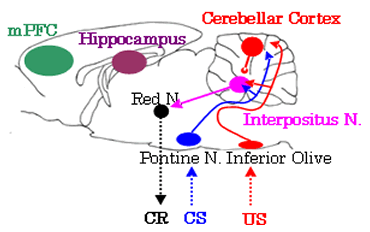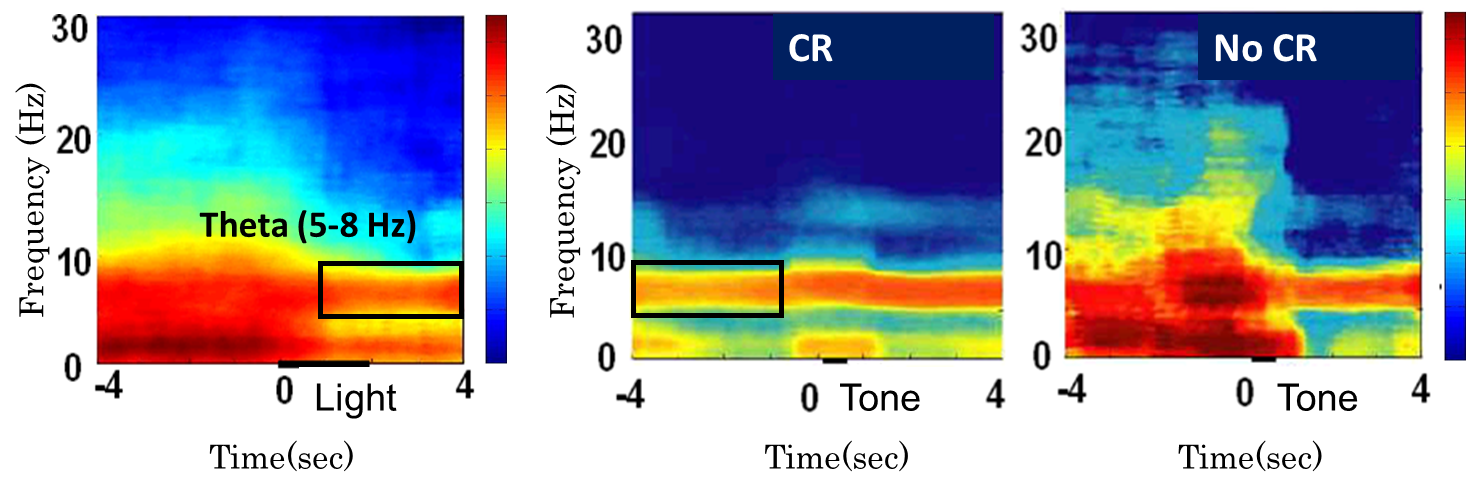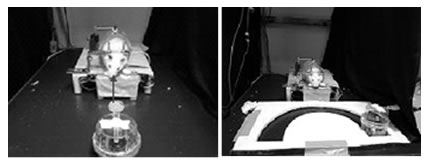生体情報システム科学専攻 Major of Biological Information Systems
Behavioral neuroscience research for learning and memory
 脳・神経システム工学 Behavioral Neuroscience
脳・神経システム工学 Behavioral Neuroscience川原 茂敬 Shigenori Kawahara
- TEL : 076-445-6871
- URL : http://evaweb.u-toyama.ac.jp/html/468_ja.html
- Keywords : Learning, Memory, Self-organization, Brain state, Brain-machine interface
研究の背景と目的 Background and Purpose of Study
脳研究における重要な留意点は、脳と言う臓器の機能をニューロンと言う構成要素の機能に全て還元できないところにある。この領域では「部分と全体(parts and the whole)」あるいは「ミクロとマクロ(micro and macro)」と言ったような洞察が必要で、非線形な性質を持つ構成要素が相互作用することによりシステムレベルで発動する巨視的性質(macroscopic parameters and order parameters) や協同現象 (cooperativity)に関する生物物理学的視点が不可欠である。我々は、実験動物における小脳依存的な瞬目反射条件付け(classical eyeblink conditioning)を対象に、脳内の自律的機能構造形成に関わる階層的制御メカニズム(hierarchical control) を明らかにしようとしている。
One of the important points in the research of brain function is that we can’t reduce most of the brain functions to the properties of its components, neurons. In this field, a view from a non-linear dynamics, such as “parts and the whole” or “micro and macro”, will be required to understand the phenomena observed at the behavioral level as well as the neural circuit level. In other words, biophysical understanding of the “macroscopic parameters” or “order parameters” of the system and the “cooperativity” among its components is essential. We have examined a relatively simple learning task, classical eyeblink conditioning, which depends largely on the cerebellum under the control of the higher nervous systems. We attempt to reveal a hierarchical control mechanism important for self-organization of functional networks in the brain.
本研究の領域横断性
当研究室で用いている瞬目反射条件付けは、マウスからヒトまで共通に見られる連合学習であり、後述するように条件付けパラダイムを多少変更することにより、脳の様々な領域の機能異常を検出することが可能である。そのため、中枢をターゲットとした様々な薬物効果や、遺伝子変異マウスの機能解析が可能である。
研究内容
1)学習メカニズムの多重性と階層的制御の解析
脳の機能を理解するためには、個体の行動から神経回路、神経細胞及び分子にわたって各階層を対応付けながら統合的に研究を行うことが求められる。瞬目反射条件付けはそのような研究を展開可能な有望な学習課題である。 瞬目反射条件付けは、音(CS)とまぶたへの侵害刺激(US)の組み合わせにより、音を聞くだけでまぶたを閉じるようになる連合学習である。この学習は、その構成要素となる下位神経回路が比較的良くわかっていることが特徴である(Fig.1)。

Fig.1. Essential and involved brain areas in classical eye blink conditioning.
この単純な運動反射の獲得および維持には小脳および脳幹が最も重要な役割を果たし、さらに、CSとUSの時間関係を変えるだけで海馬・内側前頭前野(mPFC)に対する依存性が増大する。瞬目反射条件付けは、連合学習に関与する複数の神経領域の構造と機能、及び、それら領域間の相互作用を神経回路レベルで研究することを可能にする有望な実験モデルである。現在、海馬依存性が異なる複数の学習課題(遅延課題、トレース課題、文脈依存的弁別課題)を用いて、集団的神経活動である海馬シータ波の役割を研究している。

Fig. 2. Serial feature-positive discrimination in eyeblink conditioning.
時間文脈依存的弁別課題(Serial feature-positive discrimination eyeblink conditioning)においては、光刺激提示の有無を手がかり(文脈刺激)として、その後に提示される同一の音に対して目を閉じるべきかどうかを弁別することを学習することが求められる (Fig. 2)。この時、海馬の局所場電位を記録・解析すると、光提示の後に海馬シータリズムが出現した場合に、その後の音に対して目を閉じる確率が高いことがわかってきた(Fig. 3)。これまで海馬機能の研究は迷路学習に代表されるような空間課題と、 瞬目反射条件付けのような時間課題において、それぞれ独立に行われてきた。本研究はそれら両方にまたがる領域(時間的文脈依存性)をターゲットとしており、海馬の機能について新しい知見をもたらすと期待している。

Fig. 3. Change of the hippocampal state responding to the light contextual cue, facilitating the occurrence of the conditioned eyeblink response to the tone conditioned stimulus.
2)オペラント条件付けを用いた Brain-Machine Interface の研究
我々は、近年盛んになりつつあるBrain-Machine Interface (BMI) の研究領域において、BMI訓練中の動物の神経活動変化(学習・可塑性)を解析するとともに、上記の脳科学研究より得られるシステム論的な観点を取り入れて、より良いBMIの開発に生かすことを試みている。BMIは脳と機械を直接つなぐシステムであり、脳科学とロボット工学の最先端をつなぐシステムである。また、身体のさまざまな障害を補完する臨床医学的な実用にとっても、脳を解明し人間を理解する上でも実用化が期待されている。 我々は、BMIの中でも運動出力型のBMIを取り上げ、神経活動によるロボット制御を目標としている。まずは基礎的研究として、ラットにレバー押し、及び、レバー操作によるロボットの操縦を学習させ、レバー押し中の神経活動を測定した(Fig. 4.)。得られたデータを解析してレバー押しに特徴的な神経活動を抽出し、最終的にはラットの神経活動のみでロボットを動かすことを目指している。

Fig.4. Control of a robot using left and right levers
参考文献
- Role of muscarinic acetylcholine receptors in serial feature-positive discrimination task during eyeblink conditioning in mice. Rahman MA et al. PLoS ONE 11(1): e0147572 (2016).
- Effects of environment changes on rat’s learned behavior in an elevated Y-maze. Endri Rama E et al. J. Medical and Bioengineering, 5(2): 113-118 (2016).
- Hippocampal state-dependent behavioral reflex to an identical sensory input in rats. Tokuda K et al., PLoS ONE 9(11): e112927 (2014).
- Effects of ipsilateral cerebellum ablation on acquisition and retention of classically conditioned eyeblink responses in rats. Horiuchi T and Kawahara S. Neurosci. Letters 472:148–152 (2010).
- Dual involvement of G-substrate in motor learning revealed by gene deletion. Endo S et al. PNAS 106:3525–3530 (2009).

